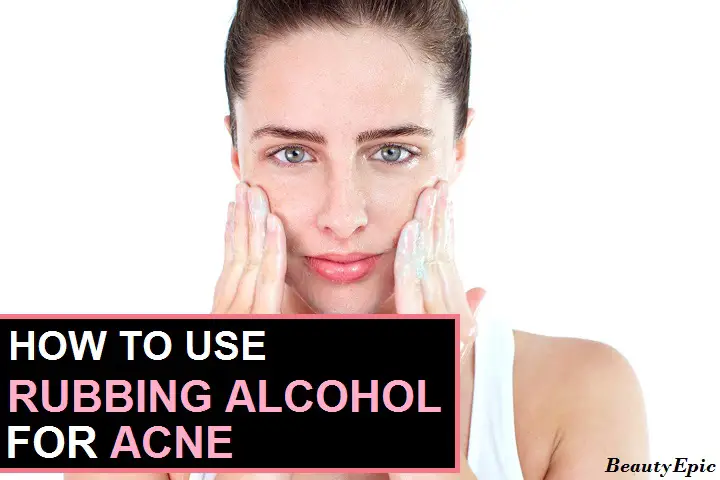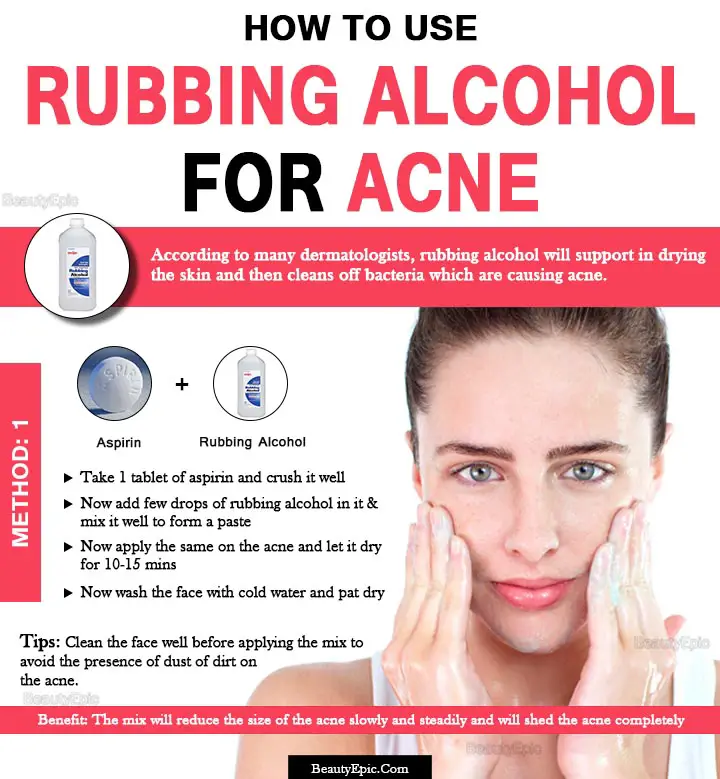
Important: This article is for informational purposes only. Please read our full disclaimer for more details.
There are several factors which are responsible for acne, but the main cause is believed to be a rise in androgen levels. Increase in androgen levels provokes the oil glands below skin to grow. Those enlarged glands leads to the production of more sebum. Too much sebum breaks down cellular walls of the pores, supporting bacteria to grow. Acne is common among people of all ages and especially among teenagers. Many say that rubbing alcohol for acne prone skin helps in getting rid of the problem.
Does Rubbing Alcohol Help Acne go Away?
According to many dermatologists, rubbing alcohol will support in drying the skin and then cleans off bacteria which are causing acne.
Benefits of Rubbing Alcohol for Acne
- When you apply alcohol on acne, it will dry the blemishes much faster.
- For People with oily skin, drying features of the rubbing alcohol will support in reducing the oiliness.
- Reduce the growth of blackheads and pimples on the acne prone skins
- How to get rid of acne with rubbing alcohol:
There are various ways of treating the problem of acne with rubbing alcohol. But there are some specific techniques which can give you the best results.
1. Aspirin and Rubbing Alcohol for Acne
Crushed aspirin with alcohol can help in reducing the size and redness of the acne on face or on any part of the body. Aspirin is a well known blood thinner so it can reduce size of acne faster.
Ingredients:
- Aspirin
- Rubbing Alcohol
Preparation Time: 5 mins
Procedure:
- Take 1 tablet of aspirin and crush it well
- Now add few drops of rubbing alcohol in it and mix it well to form a paste
- Now apply the same on the acne and let it dry for 10-15 mins
- Now wash the face with cold water and pat dry
How it work: The mix will reduce the size of the acne slowly and steadily and will shed the acne completely.
Repetitions: Once daily.
Best time to Apply: In your free time.
Tips: Clean the face well before applying the mix to avoid the presence of dust of dirt on the acne.
2. Baking Soda and Rubbing Alcohol for Acne
Baking soda is amphoteric – it can operate on both acid and a base. It helps in neutralizing the pH imbalances on the skin. Baking soda supports in drying the skin, making the Acne shed.
Ingredients:
- Baking Soda
- Rubbing Alcohol
- Cotton
- Water
Preparation Time: 2 mins
Procedure:
- First clean the acne prone area and pat it dry
- Take some rubbing alcohol in cotton and dab the area
- Now boil half cup of water and pour ½ cup of baking soda in it and make a paste
- Apply it on acne and let it dry to form a mask
- Now slowly scrub the area to remove the mask and rinse with lukewarm water
- Again wash with cold water to close pores
How it work: It will help in killing the bacteria present in acne and will exfoliate the skin with care.
Repetitions: Once daily.
Best time to Apply: In your free time.
Tips: Apply rose water to keep the skin hydrated.
[ Read: How to Use Baking Soda for Acne ]
3. Rubbing Alcohol and Tea Tree Oil for Acne
Tea tree oil is a popular fragrant essential oil which is derived from the tea tree and it gives effective result for acne treatment.
Ingredients:
- Rubbing Alcohol
- Tea tree oil
- Witch hazel
- Cotton
Preparation Time: 5 min
Procedure:
- Take few drops of rubbing alcohol in clean cotton and dab the acne prone skin
- This will clean the acne from dirt and dust
- Dilute few drops of tea tree oil with 20 to 40 drops of witch hazel, Now again take a fresh cotton and apply it on the skin
- Let it dry for 15 to 20 min and then wash your face
How it work: This will help in soothing the acne prone skin and shed the affected skin
Repetitions: Once a day.
Best time to Apply: In your free time
Tips: Do not overuse it as this may make the skin dry
[ Read: How to Use Tea Tree Oil for Acne ]
4. Rubbing Alcohol and Toothpaste for Acne
Toothpaste contains Triclosan, alcohol, menthol, hydrogen peroxide and baking soda. All the ingredients in it make the skin dry and it kills the acteria of pimples.
Ingredients:
- Rubbing alcohol
- Toothpaste
- Cornstarch
Preparation Time: 5 min
Procedure:
- Take equal amount of rubbing alcohol, cornstarch and toothpaste
- Now make a smooth paste mixing all.Apply it on the acne areas.
- Let it dry for half an hour.
- Wash your face and pat dry.
How it works: Presence of Toothpaste in the mix will irritate skin. The acne will eventually disappear with the irritation
Repetitions: Apply regularly.
Best time to Apply: In your free time
Tips: Do not use gel paste for this method of treatment. Always use non gel traditional paste in white color.
Does Rubbing Alcohol on face helps oily skin?
rubbing alcohol is a type of denatured alcohol that can be used as a cleaning agent or disinfectant. It is usually made from ethyl alcohol, which is derived from plants or petroleum. rubbing alcohol is sometimes called rubbing alcohol because it can be used to relieve muscle pain and stiffness. It can also be used to clean surfaces, such as your skin.
rubbing alcohol can help to cleanse your face and remove excess oil. It’s important to use a rubbing alcohol that is specifically designed for cleaning your face, as other types of rubbing alcohol can be too harsh and drying.
- Apply the rubbing alcohol to a cotton ball or pad and wipe it over your face.
- Rinse your face with cool water and pat it dry.
- You can use rubbing alcohol on your face once or twice a day, or as needed.
Different people have different types of skin and so some skin may or may not suit the use of rubbing alcohol for acne treatment. Speak to your dermatologist if you have any skin related problems before using rubbing alcohol for acne.
You Might Also Like:
- Does Toothpaste Help for Acne
- How To Use Apple Cider Vinegar For Acne Treatment?
- How to Use Aspirin for Acne Treatment?
- How to Use Olive oil for Acne Treatment?
- Top 5 Best Vitamins to Prevent Acne
- Baking Soda for Acne: How to Use?
- How to Get Rid of Acne Fast with Evening Primrose Oil
- The 15 Best Face Washes for Acne
- How Do You Use Coconut oil for Acne?
- How to Use Turmeric for Acne?
- How to Get Rid of Forehead Acne Naturally?
- How Does Sulfur Help with Acne?
Image:- 1
















